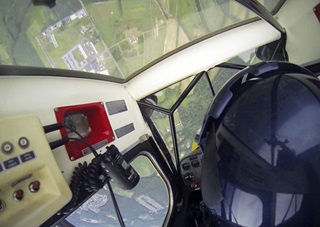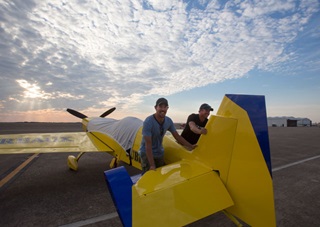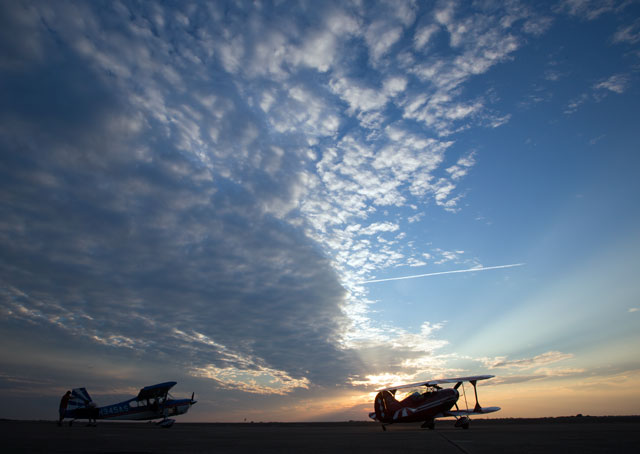
There is precious little time to think when the airplane is pointed straight down at the ground, but I took a breath. Climbing vertically into the hammerhead, a pivot timed just before the airplane would otherwise begin sliding backward toward the ground (never a good idea in a Super Decathlon), I already knew I was out of position, thanks in no small part to more than 20 knots of wind blowing through the aerobatic box.
As I completed the pivot, I saw the runway below (the only visual reference available) not quite where I thought it ought to be. Time to think fast: Which way to roll? There was probably less than a second to decide.
The Keene Fall Classic, a one-day contest held Oct. 17 by the New England Aerobatic Club (Chapter 35 of the International Aerobatic Club), drew a field of 13 pilots, nine (including myself) flying the Sportsman category, the rest in Primary. The contest was designed to welcome newcomers and favor those flying the lower categories, particularly pilots with little or no previous contest experience. (Pilots who typically flew higher performance aircraft in higher categories were tagged with penalty points from the start to handicap the field.) The Primary trophy indeed went to first-time competitor Mark Wesley, whose instructor, Rob Dumovic of Executive Flyers Aviation, took second place in Sportsman behind Pete Muntean, whose performance capped a season that left him in second place in the regional season series. Sheldon Apsell, flying an Extra 300L (apparently not penalized because he typically flies Sportsman), sneaked in ahead of me for third place in the contest; he also finished one spot ahead of me for the regional series.
Two of the four judges noted I was “short after” the quarter-roll on the downline of that hammerhead, the fraction-of-a-second hesitation proving costly. Up in the air, I had found myself close to the center of a box I had never flown before, and hesitated before rolling because I didn’t want to repeat the disastrous mistake I made in the Kathy Jaffe Challenge—turning the wrong way on that same figure and racking up zeroes thereafter because four of the following maneuvers were flown in the wrong direction. I figured it out, rolled, and pulled immediately, preferring score sheets with “short after” written on them to toying with VNE or the altitude limit of the box. Safety comes first, especially in competition. It is part of the culture of IAC that is ingrained in pilots from the start. Limits are carefully set, and respected.
A little math tells me that my 6.5 average score on the hammerhead probably cost me at least a trophy, and possibly the outright victory. I’m not kicking myself, though. A little disappointed, perhaps, but as I write this I am thinking of what I’ve gained, not the contests I lost.
I’ve come a long way since May 19, 2012, when I logged my very first hour (0.8, to be precise) in a tailwheel airplane, a lesson with Bob Cipolli that included a deep stall (holding the stick back in a stall and keeping it there for a while, yawing back and forth like a falling leaf), one-turn spins (left and right), loops, slow rolls, and my first tailwheel landing. (Cipolli saved it.) I’ve been hooked on aerobatics ever since, and building skills that will serve me well throughout my flying career.
I flew four contests this year, bringing my career total to seven, and managed to get through three of them with no score lower than 5.0 on any figure, which qualifies for an IAC stars award. I logged 32.2 hours this year, flew my first solo contest (sans safety pilot), and, with nearly 80 hours of total tailwheel time, I can be trusted (and trust myself) to handle a Super Decathlon without help. I’ve even taken two passengers for their first aerobatic rides, which was as much a thrill for me as it was for them, albeit for somewhat different reasons. I won’t say that spins bore me, because they don’t, but I used to be shy about stalls—much less a spin—and now spins are just another maneuver.
I can feel an airplane much better than I could on that first flight: The seat of my pants tells me a lot, along with the sounds, and the feel of the controls. There are no unusual attitudes, anymore. The yaw that precedes a spin can be felt, and responded to, stopping autorotation before it starts if a spin isn’t actually part of the plan. One of my first flight instructors told me over and over to “stay ahead of the airplane,” and that has become much easier to do. I have a deeper respect for my own limits, and the limits of the airplane, along with the confidence to work within those limits. One of these days I plan to take the commercial pilot checkride, and I expect lazy eights will be a piece of cake. I think the spin endorsement for the instructor certificate I plan to earn thereafter will be pretty easy, too.

I’ve also gained many friends. Most competition pilots will tell you that the second best part of the sport, after the actual flying, which is a blast, is the people you meet. Some, myself included, even put that first (it’s at least a tie). It is a small community of colorful, interesting, motivated, and accomplished people united by a love of pursuing perfect airmanship (an elusive goal, unless your name happens to be Rob Holland, and even he gets less than a perfect score most of the time).
After the flying was over, I talked with Ward Bryant, the founding president of the chapter, the man who mailed the postcards to round up some aerobatic pilots for a first meeting that led to the chapter’s 1973 incorporation, with the first judge’s school and contest held the following year. He has seen the sport, and the chapter, grow and thrive for nearly as long as I’ve been alive.
“It’s amazing,” Bryant said. “Very heartwarming, for me. It took a lot of work and a lot of good people. It’s very moving for me to come here.”
Bryant has a special place in his heart for the Pitts Special (as I do), and for the people who have kept the chapter going, welcoming new members through the years. And he has a perspective on the rewards that go beyond trophies, or even the “Ward’s Awards” he used to give out at the annual chapter banquet.
“I think aerobatics just makes a better pilot out of you. I know it does,” he said.
Bryant was assistant judge to Rick Runnels at the Keene Fall Classic, calling figures for a fellow aerobatic pilot who won trophies at the top competition level (Unlimited) in the 1980s before life took him away from the sport. (Runnels operated a charter business, and had to buy a turboprop to haul freight, which kept him out of the competition box, though he returned recently to serve as a volunteer and mentor. Runnels called his days of competition flying “the best time of my life,” and talked about how he missed the camaraderie as much as the flying.)
The work for next year has begun. Contest Director Gary DeBaun is already well along in the planning and recruiting of volunteers for the 2016 U.S. National Aerobatic Championships, which will be a selection year for the Unlimited team that will represent us in world competition. The known programs for 2016 will soon be finalized by the IAC board. I’m mildly horrified that there is no spin in the proposed Sportsman Known, and I don’t think I’m alone. Mastering spins enhances skill and safety, and prepares a pilot for the more difficult variations on autorotation flown at higher levels, such as the snap roll.
I may not manage four contests next year, and I may not move up to Intermediate just yet (for one thing, it requires snap rolls, which are hard on a Super Decathlon). But I will continue to fly competition aerobatics as long as I am able, and I hope to remain a part of this community beyond that.
“As we all know … pilots are just cool people,” Runnels said. “Pilots are just a breed of people that you want to hang out with and are really great. But then there’s another level of those pilots, and that is the aerobatic pilot, which is even cooler.”
I concur. And I’ll quote Holland, who wrapped up an interview at the U.S. National Aerobatic Championships (where he won his fifth consecutive championship this year), and join him in encouraging anyone who reads this to “fly aerobatics.”

Competition Aerobatics 101
The International Aerobatic Club organizes and sanctions aerobatic competition around the country, and the IAC website has a wealth of information for current and future competitors including links to contest schedules, aerobatic instructors, and tips on how to get started.
The author’s journey through the 2015 aerobatic competition season is documented in the articles linked below.
Mental gymnastics (July 30)
Humble pie (Aug. 10)
Among friends (Aug. 20)
Acro breakdown (Aug. 27)
Aerobatic budget (Sept. 3)
Sweet silence (Sept. 10)
Coming together (Sept. 17)
Corner man (Sept. 23)
Personal best (Sept. 24)
Texas toast (Sept. 30)
These and other AOPA articles about aerobatics are also collected here.



